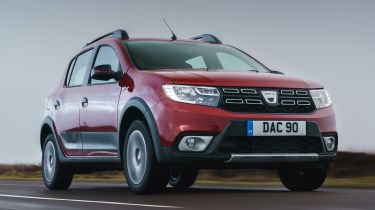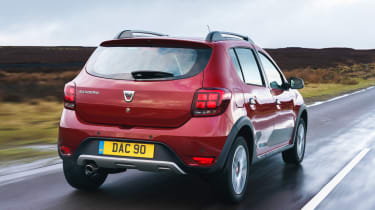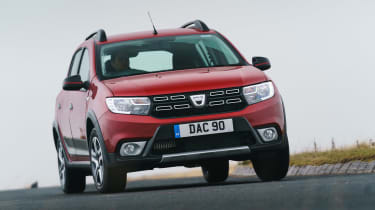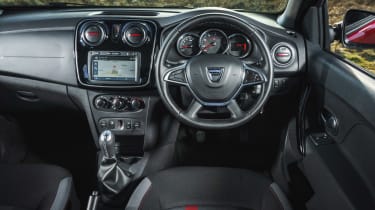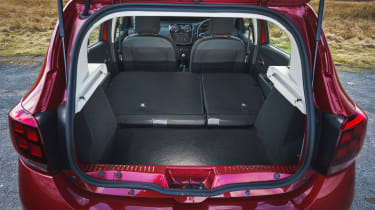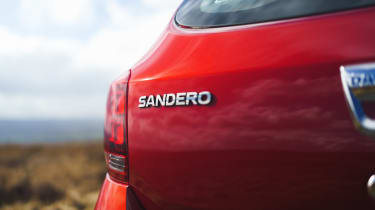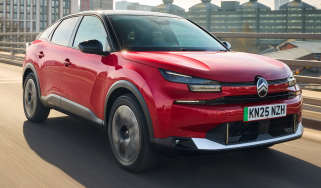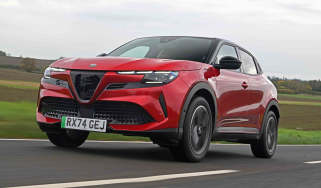Dacia Sandero Stepway (2013-2020) review
The Dacia Sandero Stepway adds a touch of rugged off-road presence to the value-focused Sandero hatch.

Dacia launched in the UK as a no-frills, budget brand offering cut-price cars that are cheap and cheerful. The regular Sandero hatchback grabbed headlines as Britain’s cheapest car when it arrived, but this wasn’t just a one-hit wonder for the company; Dacia has gone from strength to strength, adding other models to its line-up.
The Sandero Stepway is based on the Sandero hatchback, but it has a raised ride height, roof rails and black plastic cladding around the wheelarches and bumpers, which give it the look of an SUV. It sits below the Logan MCV estate and the latest Duster SUV in the Dacia range.
As the Sandero Stepway is front-wheel drive it isn’t really a serious off-roader – don’t expect it to rival a Fiat Panda 4x4 over rugged terrain – but those few features make it a little more rugged and capable of tackling bumpy surfaces than your average hatchback.
Value is what Dacia is all about, and the entry-level Sandero Stepway Essential is extremely cheap to buy, and this is reflected in the level of equipment. The rest of the line-up comprises of two models with much more in the way of standard kit: The Sandero Stepway Comfort and SE Twenty.
Used - available now

2019 Dacia
Sandero Stepway
23,428 milesManualPetrol0.9L
Cash £8,878
2022 Dacia
Sandero Stepway
43,517 milesManualPetrol-lpg1.0L
Cash £8,200
2018 Dacia
Sandero Stepway
37,846 milesManualPetrol0.9L
Cash £7,800
2022 Dacia
Sandero Stepway
19,485 milesManualPetrol1.0L
Cash £10,995There are two engine choices - a 0.9-litre three-cylinder turbocharged petrol, badged TCe 90, and a TCe 100 Bi-Fuel model.
The TCe 90 produces 89bhp and is hooked up to a five-speed manual gearbox – this is the only transmission option across the whole range. The petrol engines are sourced from parent company Renault, and have been proven in the Clio supermini and Captur crossover.
Dacia no longer offers a Sandero Stepway diesel model, instead offering a new dual-fuel petrol and LPG engine for those covering higher mileages and looking to make savings. The TCe 100 Bi-Fuel model makes 99bhp, with improved economy and emissions over the regular petrol versions.
It’s difficult to compare the Stepway to rivals because of its low price and because it sits halfway between a hatchback and a small SUV. Maybe its truest rival is the jacked up front-wheel-drive Fiat Panda City Cross.
However, it arguably occupies a similar market position to affordable, spacious cars such as the Suzuki SX4 S-Cross, the Hyundai ix20, and Honda Jazz, as well small crossovers such as the Nissan Juke and Peugeot 2008. Although it isn’t full 4x4, it could also be considered against the likes of the Suzuki Swift 4x4 and the two four-wheel-drive versions of the Fiat Panda: the Panda 4x4 and the Panda Cross.
Dacia is all about low costs, and the Stepway is extremely well priced, undercutting most of its main rivals by quite a margin. It’s also decently spacious, while the diesel engine is cheap to run and has a decent amount of mid-range pulling power.
If you’ve driven a Renault in the last decade, the Sandero Stepway is likely to feel familiar from behind the wheel, as the car uses older Renault components and switchgear. As a result, it really isn’t the most premium package. In fact, by modern standards it really feels like a lo-fi product. But this is one of the main areas where the brand has been able to save on costs, which it’s passed on to its customers. You just can't argue with the Sandero Stepway's price.
Engines, performance and drive
The Dacia Sandero Stepway shares its underpinnings with the standard Sandero hatchback. This car, in turn, is based on the Mk2 Renault Clio and as you would expect, it feels a bit dated on the move.
Opting for the Stepway version of the Sandero, with its raised ride height, injects a bit more comfort into what feels like an ageing package. However, it can't match more expensive, more up-to-date mainstream superminis for ride quality.
There’s a reasonable amount of grip, but the body rolls through corners. Plus, the steering is heavy at low speeds and provides the driver with little in the way of feedback. The gearshift is noticeably long and notchy, too. It’s hard to complain at this price, but you don’t have to look far to find another small, cheap car that’s more fun to drive.
What's more, despite its tough looks, the Sandero Stepway doesn’t offer much in the way of off-road ability. The all-season tyres give a little extra grip in tricky conditions and the raised suspension delivers additional ground clearance, but that’s it. Power is still fed to the front wheels – there isn’t a four-wheel-drive system – and the car doesn’t come with any off-road driving aids.
On the plus side, the raised ride height provides an improved view of the road, and Dacia has positioned the pedals well. Many of the old-school switchgear is chunky and easily at hand too.
Engines
The 89bhp 0.9-litre turbocharged three-cylinder unit is well suited to low-speed driving with a small amount of torque to lean on thanks to the turbo. It's still not great outside of town, but it's adequate on motorways and not well out of its depth.
For those who cover higher mileages and are looking to save costs over the longer term, then the TCe 100 Bi-Fuel model answers their brief. With 99bhp and 160Nm of torque, the TCe 100 also offers improved economy and reduced emission levels.
MPG, CO2 and Running Costs
The 0.9-litre TCe petrol model returns 44.8mpg fuel economy under WLTP rules, but of course, that figure will vary depending on how you spec your Sandero Stepway and how and where you drive it. Dacia quotes a CO2 figure of 141g/km.
The Sandero range no longer includes a diesel model, with Dacia instead opting to go with a 1.0-litre petrol/LPG Bi-Fuel version. Dacia claims that the new engine will deliver enhanced performance due to more torque and reduced fuel costs for customers - while also delivering lower emissions. However, it costs more than the 0.9-litre petrol we'd pick.
Insurance groups
Insurance groups are low enough to complement the Sandero Stepway’s budget characteristics – mainly because it’s very cheap to buy and also because it uses established, previous-generation Renault parts, which are inexpensive to replace.
No Sandero Stepway should be expensive to insure - the 1.0-litre TCe 100 Bi-Fuel SE Twenty is in group nine, while our pick of the Sandero Stepway line-up is the mid-range Comfort TCe 90 petrol, also in group nine.
Depreciation
Any Sandero Stepway won't set you back too much at purchase, and none of them should lose too much value over three years either. According to our experts you can expect Stepway versions of the Sandero to hold on to more of their purchase price than regular, non-jacked up versions. A 0.9 TCe Comfort Sandero Stepway should still be worth half what you paid for it three years and 36,000 miles later.
Interior, design and technology
The standard Dacia Sandero supermini is a relatively rugged looking, unfussy car – and that translates well to the SUV-inspired Stepway. In fact, the transformation has been a success.
Dacia has bulked up the Sandero Stepway with plastic wheelarch extensions and sills, as well as chrome roof bars, while the ride height has been increased by 100mm over the standard Sandero. All of these changes help it stand out from the basic five-door compact hatchback, and overall, it has a more upmarket feel due to the sprinkling of SUV style.
Unlike the regular Sandero, the Stepway is not available in entry-level Access trim – the basic hatch has unpainted bumpers, steel wheels and less equipment, but an even lower starting price. Instead, buyers of the Sandero Stepway can only choose from the Stepway's more upmarket specifications, all equipped with body-coloured bumpers, satin chrome roof bars as well as stylish plastic wheel covers that can easily be mistaken for a set of alloys.
Despite the exterior differences, the Stepway is pretty much the same as the Sandero hatchback inside. It has the same logical dashboard layout, lots of hard plastics and plenty of switches that are familiar from older Renault models. It’s basic and quite outdated, but everything feels robust and the driving position is also comfortable.
The Sandero Stepway Essential gets a very short list of standard tech equipment. You'll find electric windows up front but those in the rear are manual, while the mirrors are adjusted manually as well. Comfort spec cars add electric adjustment for the door mirrors, an upgraded steering wheel, cruise control, sat-nav and rear parking sensors.
The range-topping SE Twenty model looks the smartest of the bunch and features plenty of styling upgrades alongside a standard reversing camera. If you like the look it's one to go for - the price premium isn't too much to bear.
A handful of extra packs can be optioned, mostly including accessories such as a towbar, mud flaps and a central armrest.
Sat-nav, stereo and infotainment
When you look at the starting price tag of the Sandero Stepway Essential you shouldn't expect much in the way of cabin technology. It comes with Bluetooth, as well as USB and auxiliary connections and DAB radio as standard. However, you'll have to step up a trim level to the Comfort model get any sort of infotainment screen.
Due to their basic nature, Dacias don’t have the most advanced infotainment systems on the market. The Sandero Comfort and range-topping SE Twenty get a seven-inch colour touchscreen system that's pretty rudimentary. It's small, not the quickest to respond to the touch and low-resolution, but it comes with built-in navigation plus Apple CarPlay and Android Auto. Appearing alongside the screen, two more speakers are added to the stereo setup.
Practicality, comfort and boot space
The Dacia Sandero Stepway is a pretty bulky small car and as a result it’s decently practical. With its raised ride height and SUV-style exterior, you could be fooled into thinking that this model has a bigger interior than the standard Sandero hatchback. But that isn’t the case – inside, it’s essentially the same robust, no-frills five-seater.
There are decent-sized door bins while all cars feature pockets in the rear seats and a 60:40 folding rear bench. It also includes transverse bars for the standard roof rails, to help with carrying those big loads you can’t fit inside the car. The boot sizes up at 320-litres, which is strong for the supermini class. Fold the rear seats almost flat and there's a vast 1,200 litres offered.
Size
The Stepway rides 100mm higher than the standard Sandero hatchback, and is 1,618mm tall as a result. But it retains roughly the same basic dimensions in other respects. It’s the same 1.73mm width, although the big, black plastic bumpers make it 23mm longer than the hatchback, at 4,081mm. It’s actually taller than the Nissan Juke – which is 1,565mm high – and isn’t much shorter than the big-selling crossover, either, as the Juke measures 4,135mm long.
Leg room, head room & passenger space
There’s a healthy amount of space inside the Sandero Stepway – more than you’d expect to find in most superminis. Its no-frills status means the seats don’t do anything clever, but chances are you’ll find more legroom and headroom inside the Dacia than in most other cars of this size and certainly at this price.
Reliability and Safety
The Sandero Stepway should prove reliable enough; the 900cc petrol engine is shared with models in the latest Renault range, as is the five-speed manual box, and the rest of the tech is lifted from the previous-generation Clio supermini. These components have been around for a while, so any problems should hopefully have been ironed out by now, plus the Dacia’s simplicity means there’s less to go wrong in the first place.
The Sandero didn't feature in our latest Driver Power customer satisfaction survey, but Dacia as a brand will want to improve quickly following a run of low placings in recent polls.
Despite its budget roots, the Sandero Stepway comes with a respectable haul of safety kit, too: all versions get four airbags, ABS, stability control, traction control, hill start assist, tyre pressure monitoring and Isofix child seat mountings.
However, Euro NCAP awarded the standard Sandero a four-star crash test score, which isn't the best when the maximum five-star score is the general standard for most modern superminis. That test score is from 2013 too, so is somewhat outdated too. There are certainly safer choices out there if this is a big factor in your purchasing decision.
The Sandero Stepway hasn't been put through the test separately, but you can expect an identical level of protection in the event of a crash.
Warranty
Like the Sandero hatchback, Dacia supplies the Sandero Stepway with a run-of-the-mill three-year/60,000-mile warranty. That’s less than parent company Renault offers with its own models, which have four-year/100,000-mile warranties, but then you have to remember how much cheaper Dacias are.
And besides, buyers can specify longer warranties when ordering their car in the showroom for an extra cost, all the way up to seven years of coverage.
Servicing
As with many of its competitors, Dacia offers a pre-paid servicing pack that helps customers budget for costs. This scheme takes care of mechanical maintenance for three years and 30,000 miles, and is priced at £350. There’s also a four-year/40,000-mile option for £650.

